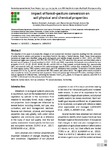Impact of forest-pasture conversion on soil physical and chemical properties

Use este enlace para citar
http://hdl.handle.net/2183/31552Colecciones
Metadatos
Mostrar el registro completo del ítemTítulo
Impact of forest-pasture conversion on soil physical and chemical propertiesAutor(es)
Fecha
2021Cita bibliográfica
Dortzbach, D., Pereira, M. G., Paz Gonzalez, A., Queiroz dos Santos, O. A., Piccolo, M. de C., & Loss, A. (2022). Impact of forest–pasture conversion on soil physical and chemical properties. Revista Agrogeoambiental, 13(4). https://doi.org/10.18406/2316-1817v13n420211655
Resumen
[Abstract:] The objective of this paper is to assess the changes in soil physical and chemical properties resulting from the conversion of native forest to pasture and pasture to secondary forest in the state of Santa Catarina, Brazil. Seven forest–pasture successional stages were identified using aerial photographs and satellite images acquired in 1957, 1978, and 2008. Successional stages were coded as FFF, FPF, PFF, PPF, FPP, FFP, and PPP, where the first, second, and third letters refer to the land uses (P, pasture; F, forest) practiced in 1957, 1978, and 2008, respectively. Soil samples were collected by layer at depths of 0–10, 10–20, 20–40, 40–60, 60–80, and 80–100 cm. Clay contents, soil bulk density (Db), macroporosity (MP), microporosity (mP), pH, Aluminum (Al), cation exchange capacity (CEC), calcium (Ca), potassium (K), phosphorus (P), total organic carbon (TOC) content, carbon stock, and δ13C abundance were quantified. Conversion of forest to pasture increased soil P, K, Ca, Db, and mP; and reduced MP, TOC content, and carbon stocks. The largest carbon stocks occurred in sites occupied by forests but previously used as pastures. Forest and pasture age influenced δ13C values, resulting in different isotopic signatures for different sites, confirming the transition from C3 to C4 plants. In 50-year-old pastures, about 66 % of soil TOC is still derived from the primary forest biomass.
Palabras clave
Carbon stocks
Soil use conversion
13C natural abundance
Soil fertility
Soil use conversion
13C natural abundance
Soil fertility
Versión del editor
Derechos
Atribución 3.0 España






